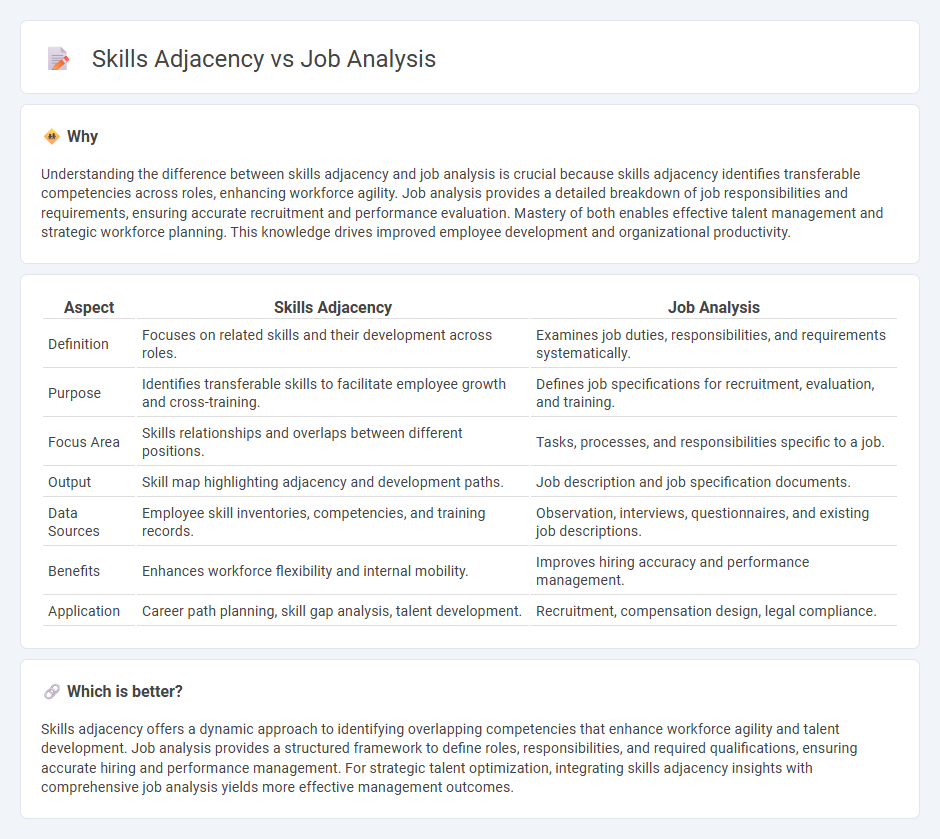
Skills adjacency focuses on identifying competencies closely related to those required for a specific job to enhance workforce flexibility and talent development. Job analysis systematically examines roles to detail essential tasks, responsibilities, and required qualifications, serving as a foundation for recruitment, training, and performance evaluation. Explore how integrating skills adjacency with comprehensive job analysis can transform your management strategy.
Why it is important
Understanding the difference between skills adjacency and job analysis is crucial because skills adjacency identifies transferable competencies across roles, enhancing workforce agility. Job analysis provides a detailed breakdown of job responsibilities and requirements, ensuring accurate recruitment and performance evaluation. Mastery of both enables effective talent management and strategic workforce planning. This knowledge drives improved employee development and organizational productivity.
Comparison Table
| Aspect | Skills Adjacency | Job Analysis |
|---|---|---|
| Definition | Focuses on related skills and their development across roles. | Examines job duties, responsibilities, and requirements systematically. |
| Purpose | Identifies transferable skills to facilitate employee growth and cross-training. | Defines job specifications for recruitment, evaluation, and training. |
| Focus Area | Skills relationships and overlaps between different positions. | Tasks, processes, and responsibilities specific to a job. |
| Output | Skill map highlighting adjacency and development paths. | Job description and job specification documents. |
| Data Sources | Employee skill inventories, competencies, and training records. | Observation, interviews, questionnaires, and existing job descriptions. |
| Benefits | Enhances workforce flexibility and internal mobility. | Improves hiring accuracy and performance management. |
| Application | Career path planning, skill gap analysis, talent development. | Recruitment, compensation design, legal compliance. |
Which is better?
Skills adjacency offers a dynamic approach to identifying overlapping competencies that enhance workforce agility and talent development. Job analysis provides a structured framework to define roles, responsibilities, and required qualifications, ensuring accurate hiring and performance management. For strategic talent optimization, integrating skills adjacency insights with comprehensive job analysis yields more effective management outcomes.
Connection
Skills adjacency enhances job analysis by identifying related competencies that improve role clarity and employee development. Comprehensive job analysis gathers detailed information about job requirements, which aligns with adjacent skills to optimize recruitment, training, and performance evaluation. Integrating skills adjacency into job analysis supports strategic workforce planning and drives organizational effectiveness.
Key Terms
Job Description
Job analysis involves systematically identifying and detailing the responsibilities, tasks, and qualifications required for a specific job, providing a clear foundation for creating accurate job descriptions. Skills adjacency maps related or complementary skills that candidates might possess, enhancing the scope of job descriptions by highlighting transferable abilities and potential growth areas. Explore how integrating job analysis with skills adjacency can optimize your job descriptions for better talent acquisition strategies.
Competency Mapping
Job analysis identifies specific duties and responsibilities to establish clear job descriptions, while skills adjacency explores related skills that complement core competencies. Competency mapping integrates insights from both by aligning job requirements with skill sets, enabling precise talent management and development. Discover how leveraging competency mapping enhances recruitment and workforce optimization.
Skill Gap Analysis
Job analysis identifies the tasks, responsibilities, and qualifications required for a specific position, providing a foundation for recruitment and performance management. Skills adjacency evaluates the relationship between skills, highlighting areas where skills can transfer or overlap, which is crucial for effective Skill Gap Analysis. Explore more to understand how integrating job analysis and skills adjacency can optimize workforce development and training strategies.
Source and External Links
Job Analysis: Importance, Methods, and Implementation - This webpage provides an overview of job analysis, emphasizing its importance in hiring decisions and its utility in developing job descriptions and managing employee performance.
Job Analysis: A Practical Guide - This guide offers insights into the systematic process of job analysis, including its role in recruitment, organizational structure, and compensation decisions.
Job Analysis - This webpage outlines the systematic process of job analysis, focusing on identifying tasks and competencies required for successful job performance.
 dowidth.com
dowidth.com